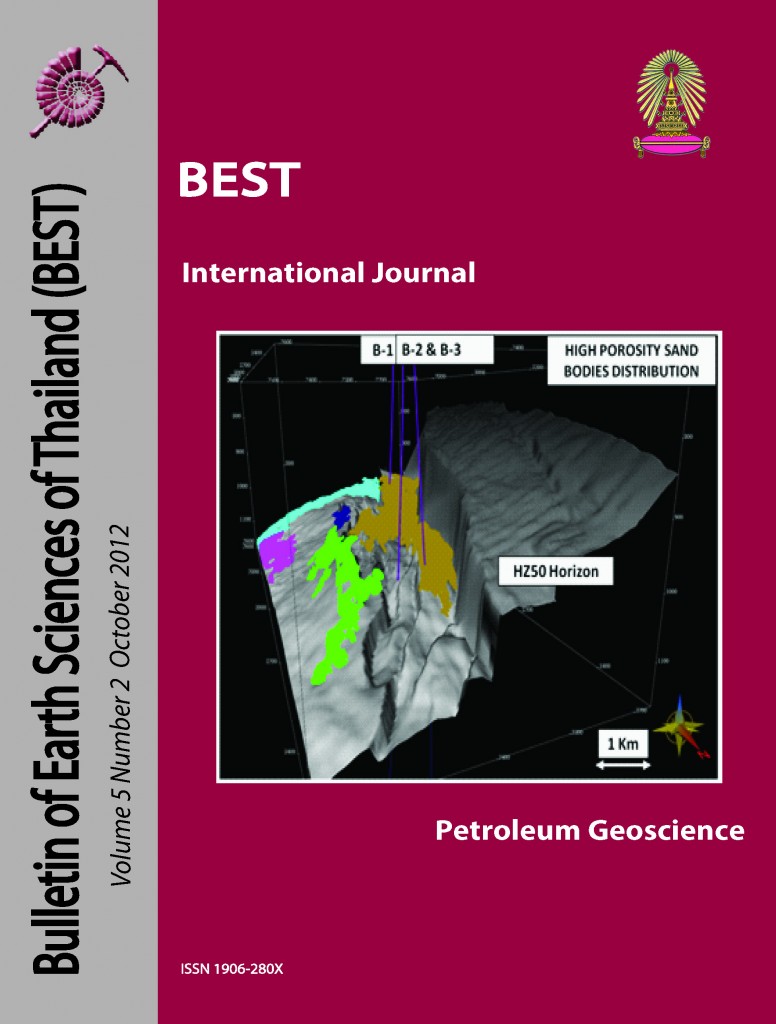Maturity Modeling of Gomin and South Gomin fields Southern Pattani Basin, Gulf of Thailand
Main Article Content
Abstract
Two explorations wells found oil in the South Gomin area. To understand where the oil came from, 3D seismic plus wireline logs from ten wells were used to model maturity based on the depth of each formation, the present formation thickness, the earliest age of deposition plus the lithologies and amount of erosion represented by unconformities. Some of the wells were not drilled deep enough to penetrate the source rock; in those cases, source rock burial depth was determined from seismic data. Oligocene and
Lower Miocene source rocks are overmature across the study area except in the east where they are still in the main gas generation phase. Lower middle Miocene source rocks are in the main gas generation phase to the west and in the oil generation window (mid to late mature) to the east. The upper middle Miocene and upper Miocene to Pliocene source rocks are in the early to late mature oil generation phase. The maturity model closely matches the hydrocarbon discoveries for Oligocene, lower Miocene and upper Miocene source rocks except for two wells that found gas in upper Miocene source rocks where it is mature for oil generation, although both are close to the oil/gas generation boundary. Most wells found gas in upper middle Miocene and upper Miocene to Pliocene source rock but the maturity model predicts oil generation. The gas probably migrated from older, more deeply buried source rocks that have matured to the gas generation phase. The models indicate that maturity levels are suitable for hydrocarbon generation throughout the study area. This suggests that there is remaining exploration potential, especially in the southeast where few wells have been drilled.
Article Details

This work is licensed under a Creative Commons Attribution-NonCommercial-NoDerivatives 4.0 International License.
Copyright © 2008 Department of Geology, Faculty of Science, Chulalongkorn University. Parts of an article can be photocopied or reproduced without prior written permission from the author(s), but due acknowledgments should be stated or cited accordingly.
References
Baldwin, B., and Butler, C.O., 1985, Compaction curves: American Association of Petroleum Geologists Bulletin, v. 69, p. 622–626.
Bustin, R., and Chonchawalit A., 2003, Petroleum Source Rock Potential and Evolution of Tertiary Strata, Pattani Basin, Gulf of Thailand: The American Association of Petroleum Geologists Bulletin, v.81, no. 12 (December 1997), p.2000-2023.
Jardine, E., 1997, Dual Petroleum Systems Governing the Prolific Pattani Basin, Offshore Thailand: Indonesian Petroleum Association, Proceedings of an International Conference on Petroleum Systems of SE Asia and Australasia, May 1997.
Sclater, J.G., and Christie, P.A.F., 1980, Continental stretching: An explanation of post-mid-Cretaceous subsidence of the central North Sea basin: Journal of Geophysical Research, v. 85,p. 3711–3939.
Waples,D.W., 2000, The kinetics of oil cracking and gas formation: Constraints from experimental and empirical data, and from thermodynamics: Organic Geochemistry, v. 31, no. 6,p. 553–575.


